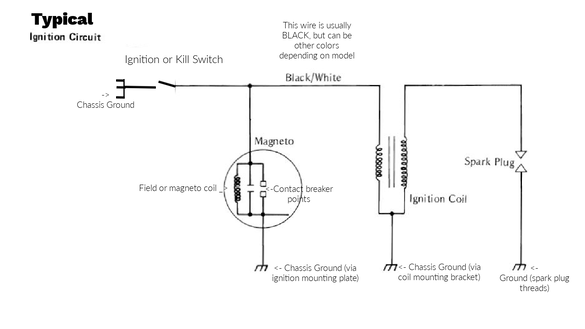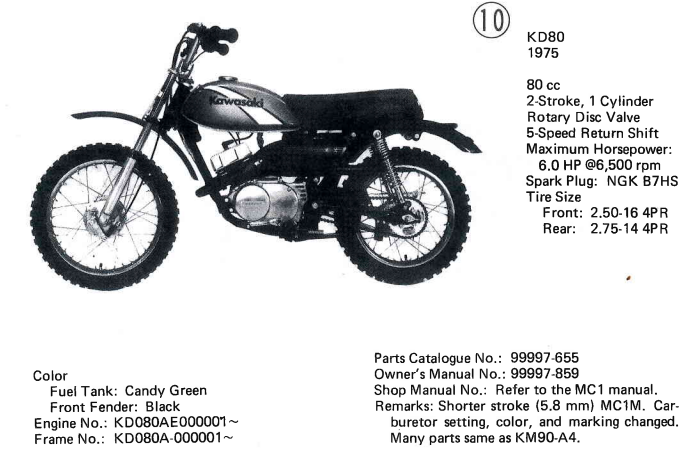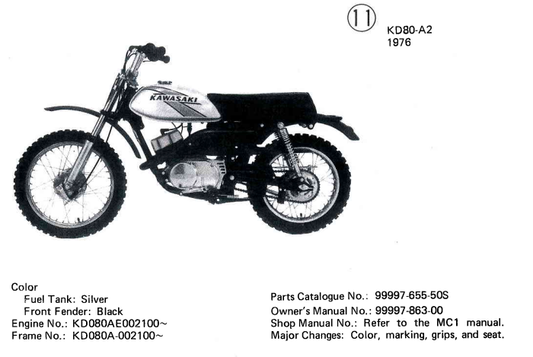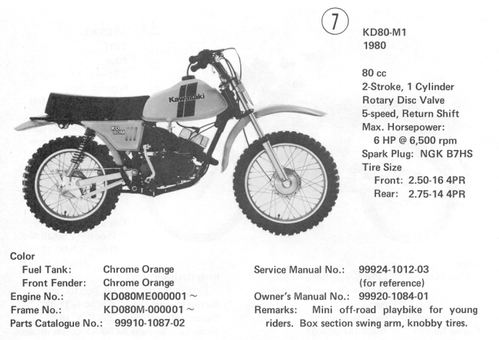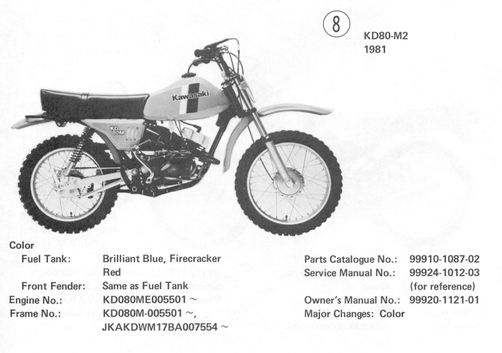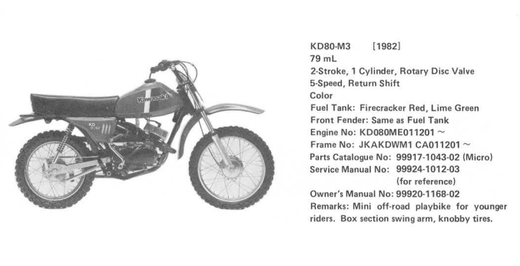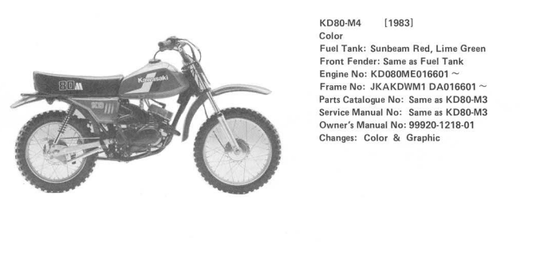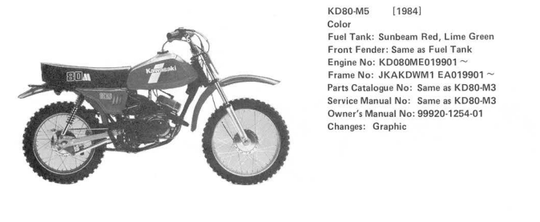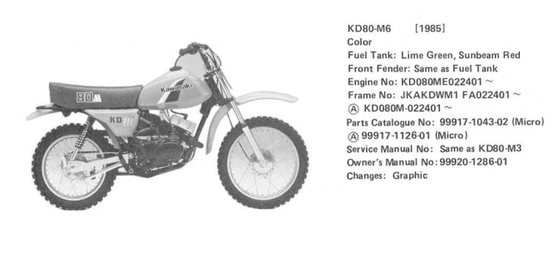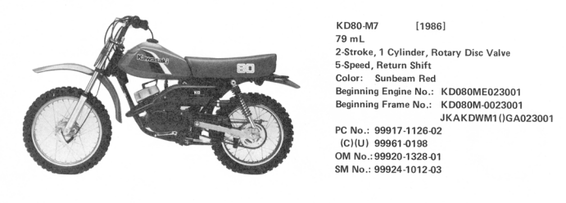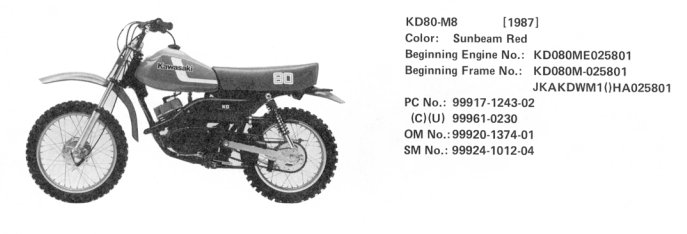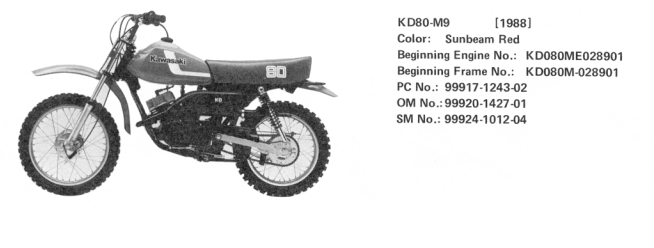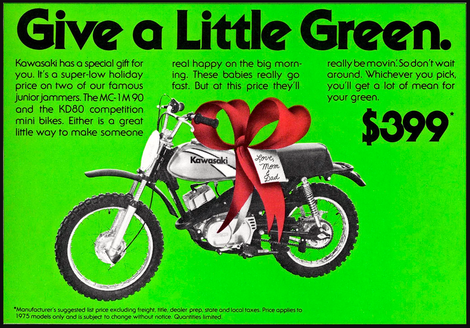 The KD80 was a great first bike for that young rider.
The KD80 was a great first bike for that young rider.
80CC
KD80 1975-1988 model identification guide
The smallest displacement of Kawasaki's rotary valve bikes. These bikes are largely built off of the internals of the 90cc rotary valve class of bikes. See 90cc page for more elaborate details and lineage. The KD80 (rotary valve version) remained virtually unchanged in its basic design, styling and performance in its 13 year run.
In 1988 the KD80-N1, known as the KD80X model, would get a complete re-design. The KD80-N1 would ditch the rotary valve engine configuration in favor of a reed valve design. It would also have smaller wheels, different suspension, expansion chamber exhaust and more modern styling. Overall it would still keep the "playbike" performance and aesthetics while having some (pee-wee class) competition performance.
These bikes however share nothing with the KDX80 & KX80, which are true competition mini bikes. These are styled after the KDX/KX line of motorcycles. They feature Kawasaki's Uni-Trak (single shock linkage) rear suspension and reed valve induction among other advancements for performance.
From a restoration standpoint the KD80 is a great beginner project bike. It is simple in design and operation. It shares a lot of internal parts with other bikes so parts are plentiful. The only downside is it is/was never mean for adults to ride. This could be a perfect vintage bike for a young rider to appreciate newer bikes and innovations as well as teach the basics of motorcycle mechanics.
KD80 1975-1988 model identification guide
The smallest displacement of Kawasaki's rotary valve bikes. These bikes are largely built off of the internals of the 90cc rotary valve class of bikes. See 90cc page for more elaborate details and lineage. The KD80 (rotary valve version) remained virtually unchanged in its basic design, styling and performance in its 13 year run.
In 1988 the KD80-N1, known as the KD80X model, would get a complete re-design. The KD80-N1 would ditch the rotary valve engine configuration in favor of a reed valve design. It would also have smaller wheels, different suspension, expansion chamber exhaust and more modern styling. Overall it would still keep the "playbike" performance and aesthetics while having some (pee-wee class) competition performance.
These bikes however share nothing with the KDX80 & KX80, which are true competition mini bikes. These are styled after the KDX/KX line of motorcycles. They feature Kawasaki's Uni-Trak (single shock linkage) rear suspension and reed valve induction among other advancements for performance.
From a restoration standpoint the KD80 is a great beginner project bike. It is simple in design and operation. It shares a lot of internal parts with other bikes so parts are plentiful. The only downside is it is/was never mean for adults to ride. This could be a perfect vintage bike for a young rider to appreciate newer bikes and innovations as well as teach the basics of motorcycle mechanics.
|
KD80 specifications and adjustments
Oiling system: Kawasaki's Super-Lube Transmission Oil: 10-30W or 10-40W Ignition system: Contact breaker point, Points gap: 0.3mm~0.4mm (see wiring diagram) Carburetor Settings Type- VM19SC (19mm) Main Jet - 80 Needle Jet - 4EJ 7-3 Pilot Jet - 17.5 Cutaway - 2.0 Air screw - 1-1/2 turns out |
For early 85cc (1965-1968) J-series bikes see 90cc models page
|
KD80A 1975
*motocross version Engine No. KD080AE000001- Frame No. KD080A-000001- Smaller displacement version of the MC1M. This model was aimed at young or entry level competition riders. Shares a lot with the MC1M and other 90cc models |
|
KD80A1 1976
*minor updates Engine No. KD080AE002100- Frame No. KD080A-002100- Tank color and graphics only revision. See MC1M |
KD80A2 1977
*styling changes
First year for the plastic fuel tank.
*1978
*1979
*missing information Contact if you have information
*styling changes
First year for the plastic fuel tank.
*1978
*1979
*missing information Contact if you have information

